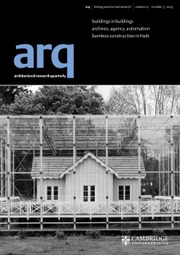Article contents
The case for an oral architecture: carpentry and communal assembly among the Dong of Southwest China
Published online by Cambridge University Press: 11 October 2016
Extract
Chinese architecture was for a long time ignored because it was not produced by architects and because it did not follow Western classical expectations, and vernacular architecture was little discussed until the 1960s, and only recently embraced by its own encyclopaedia. Yet the division of labour between drawing architect and practical builder was never wholly advantageous or inevitable, for specialisation of roles can lead to differentiation, inequality, and division, as well as constructional efficiency. Only in the last century has the division between office work and construction site become so complete, resulting in losses as well as gains. Most obviously it has removed design from making, the person with the drawing pen no longer obliged to experience the materials in their weight and texture, or to discover by handling them the best ways to work them. The designer who has never picked up a brick or wielded a chisel can possess little sensibility for the material, but as long as their duties are fulfilled on paper with apparent competence, the process is carried through. On the receiving end, bricklayer or carpenter must produce what drawings demand even when good sense seems lacking, so they carry the work through grumpily without conviction instead of participating in the creative process. This paper looks at oral architecture in the Dong culture, and the way in which buildings have traditionally been produced by carpenters along with the local community, accompanied by shared rituals which reinforce their significance.
Information
- Type
- History
- Information
- Copyright
- Copyright © Cambridge University Press 2016
- 1
- Cited by

